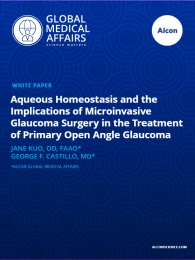

KEY TAKEAWAY POINTS
• Schlemm’s canal physiology is altered in the glaucoma disease state, with most of the resistance downstream of the TM
• The pulsatile quality of aqueous outflow is analogous to that of the cardiovascular system, and improvement in outflow facility may be accomplished by optimizing shear stress as early as possible, which may contribute to preserving TM function
• Avoidance of herniation of the TM into the outer wall of SC to preserve the pulsatile nature of aqueous outflow may have a larger effect on IOP control than simply bypassing the TM
• No current treatment has achieved the ability to restore normal flexibility and permeability of the TM and SC, or to rejuvenate the downstream collector system
• The Hydrus Microstent uniquely combines the ability to bypass the diseased TM while maintaining the patency of SC throughout the length of the implant, preserving the pulsatile nature of aqueous outflow


